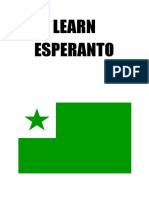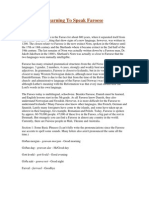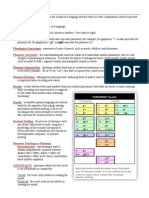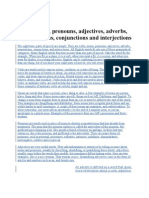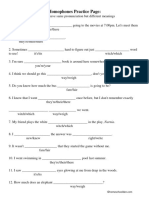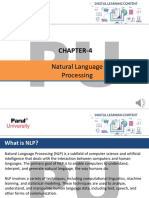Amis Language Brief Summary
Amis Language Brief Summary
Uploaded by
玄同緒雲Copyright:
Available Formats
Amis Language Brief Summary
Amis Language Brief Summary
Uploaded by
玄同緒雲Original Description:
Copyright
Available Formats
Share this document
Did you find this document useful?
Is this content inappropriate?
Copyright:
Available Formats
Amis Language Brief Summary
Amis Language Brief Summary
Uploaded by
玄同緒雲Copyright:
Available Formats
Amis language
Amis is the Formosan language of the Amis AKA Ami, an indigenous tribal people living along the east coast
of Taiwan (see Taiwanese aborigines). It is spoken from Hualien in the north to Taitung in the south, with
another population near the southern end of the island, though the northern varieties are sometimes considered a
separate language.
Government services in counties where many Amis people live in Taiwan, such as the Hualien and Taitung train
stations, broadcast in Amis alongside Mandarin. However, few Amis under the age of 20 in 1995 spoke the
language, and it is not known how many of the 138,000 ethnic Amis are speakers.
Dialects
Amis is a dialect cluster. The northern varieties, Sakizaya and Nataoran, are divergent enough to be classified as
separate languages. Within Amis proper, there are Tavalong-Vata'an, Middle, and Southern dialects, the latter
including Malan and Hengchun Amis.
Phonology
The following discussion covers the central dialect of Amis (Maddieson & Wright).
Consonants
Nasals
Plosives and
affricate
Fricatives
Trill
Lateral flap
Approximants
Labial
m
Dental
nn
Alveolar
tn
n ~ n
Palatal
Velar
Epiglottal
Glottal
tts
s
r
()
The voiceless plosives /p t k / and the affricate /tts/ are released in clusters, so that ccay "one" is pronounced
[ttsttsaj]; as is /s/: spat "four" is [spat]. The glottal stop is an exception, frequently having no audible release
in final position. The voiced fricatives, /v / (the latter found only in loanwords) are devoiced to [f x] in
utterance-final and sometimes initial position. // may be interdental or post-dental. The sibilants, /tts s/, are
optionally palatalized ([tt ]) before /i/. /j/ does not occur in word-initial position. // is often post-alveolar, and
in final position it is released: [uu] "fog".
// shows dramatic dialectical variation. In Fengbin, a town in the center of Amis territory, it is pronounced as a
central dental fricative, [n], whereas in the town of Kangko, only 15 km away, it is a lateral [n]. In northern
Amis, it is a plosive [dn ], which may be laxed to [n] intervocalically. The epiglottals are also reported to have
different pronunciations in the north, but the descriptions are contradictory. In Central Amis, // is always
voiceless, and // is often accompanied by vibrations that suggest it involves an epiglottal trill, sometimes
transcribed "". Edmondson and Elsing report that these are true epiglottals initially and medially, but in
utterance-final position they are epiglottopharyngeal.
Sakizaya, sometimes considered a northern dialect of Amis, contrasts a voiced /z/ with voiceless /s/.
In the practical orthography, /ts/ is written <c>, /j/ <y>, // <'>, // <^>, // <d>, // <ng>, and // <x>.
Vowels
Closed
Mid
Open
Front
i
Central
Back
u
( )
a
Amis has three common vowels, /i a u/. Despite the fact that a great deal of latitude is afforded by only needing
to distinguish three vowels, Amis vowels stay close to their cardinal values, though there is more movement
of /a/ and /u/ toward each other (tending to the [o] range) than there is in front-vowel space (in the [e] range).
A voiceless epenthetic schwa optionally breaks up consonant clusters, as noted above. However, there are a
small number of words where a short schwa (written e) may be phonemic. However, no contrast involving the
schwa is known, and if it is also epenthetic, then Amis has words with no vowels at all. Examples of this e are
malmes "sad", pronounced [ma m s], and nem "six", pronounced [n m] or [ n m].
Examples of words
lotong: monkey/ape
fafoy: pig
wacu: dog
pusi: cat
kudiwis: hare
Compare with Tagalog baboy (pig), tatlo (3), apat (4), lima (5), anim (6), pito (7), walo (8)
Compare with Kapampangan asu (dog), pusa (cat), atlo (3), apat (4), lima (5), anam (6), pitu/pito (7),
walu/walo (8), siyam (9), apulu/apulo (10) and ama (father) and ima (mother)
Compare with Ilokano baboy(pig), aso(dog), pusa(cat), maysa(1), dua(2), tallo(3), uppat(4), lima(5),
inem(6), pito(7), walo(8), siam(9), sangapulo(10)
ma olah kako mimali = I like to play sports.
takaraw ko pi takod = I jump very high.
kalamkam ko kacomikay = I run very fast.
Ira ko tataangay a mata a ko = I have big eyes
mamangay a ngapa = A small mouth
takayaay a fokes = long hair
sowalsan ko kahaccay a tamdaw makapahay kako = Everyone tells me that I am beautiful.
ma fanaay mi asikmisawsaw to kaysingmilidong to fodoy = I can sweep the floor, wash dishes and
clothing.
ma olah midmak kako to tayal no loma = I love to do household chores.
nawhani ma olah kako to lomano mako = Because I love my home.
[]
(marker)
[7]
ko
no
to
o/u
()
ci
ni
ci...an
ci
()
ca
na
ca...an
ca
< +
"ci ()+">
Mimaomahay ci wama.()
mimaomahay()wama/ama/mamaci(
)
Misaholoay ci ina.()
misaholoayholo/hemay(hmay)ina/wina
--(VSO)
< +
"ko ()+"+
"to ()+">
Mifaca' ko kaying to riko'.()
Mifaca' koya kaying to riko'.()
mifaca'()kayingriko'/fudoy
--(VSO)
< +
"ko ()+/"+
"i ()+">
Mararid ko olah ningra i takowan.()
ma-rarid"()"""koningra""( 3 )
olah()i""""(ko olah ningra)(takowan)takowan""( 1 )
Grammar
Verbs in the Amis language have some inflections, including existential clause, active voice, passive voice,
disposal sentence, imperative mood, optative mood, and prohibitive mood.
There are two word orders in Amis language, called "General" Word Order and "Special" Word Order.
Below are some examples of Amis sentence:
"General" Word Order Sentence I : Verbsubject
Verb
Verb, Adjective, etc.
Subject
ko (Preposition for Subjects)+Nouns
Example
Maomahay ko wama. (The father is working at the farmfield.)
o mimaomahay: Working (at farmfield)
o wama: Father
Misaholoay ko wina. (The mother is cooking rice.)
o misaholoay: Cooking (rice)
o ina/wina: Mother
"General" Word Order Sentence II : Verbsubjectobject
Verb
Verb, Adjective, etc.
Subject
ko (Preposition for Subjects)+Nouns
Object
to (Preposition for Objects)+Nouns
Example
Mifaca' ko kaying to riko'. (The young woman is washing cloth.)
Mifaca' koya kaying to riko'. (The young woman is washing cloth.)
o mifaca': wash(clothes)
o kaying: young woman
o riko'/fudoy: cloth
You might also like
- Topic 4 - TaRL Literacy Activities (Beginner and Letter Level)Document53 pagesTopic 4 - TaRL Literacy Activities (Beginner and Letter Level)Sara Jean Nace100% (1)
- Afaraf (Afar Language) & Its Dictionary PreparationDocument19 pagesAfaraf (Afar Language) & Its Dictionary Preparationmichael_lheureux969780% (10)
- Romani Language Education (Lovari)Document37 pagesRomani Language Education (Lovari)Virtual 3DNo ratings yet
- Leer Jouself Nama/teach Yourself NamaDocument19 pagesLeer Jouself Nama/teach Yourself NamaVanessa PhillipsNo ratings yet
- Lancashire Dialect NotesDocument7 pagesLancashire Dialect NotesJeffrey ParkerNo ratings yet
- Vietnamese Flash Cards Ebook: The Complete Language Learning Kit (200 digital flash cards, 32-page Study Guide, free download or stream native-speaker audio recordings)From EverandVietnamese Flash Cards Ebook: The Complete Language Learning Kit (200 digital flash cards, 32-page Study Guide, free download or stream native-speaker audio recordings)No ratings yet
- Fitisemanu, Samoan Federation Amicus Brief Appendix of ExhibitsDocument495 pagesFitisemanu, Samoan Federation Amicus Brief Appendix of ExhibitsEquallyAmericanNo ratings yet
- Tibetan Language CourseDocument318 pagesTibetan Language CourseK Tatiana Lezama C100% (2)
- 07 A Reference Grammar of Modern Standard Arabic PDFDocument731 pages07 A Reference Grammar of Modern Standard Arabic PDFWarsame SheedheerNo ratings yet
- Shays' RebellionDocument13 pagesShays' RebellionAnonymous kKGY950vdQNo ratings yet
- Warren Michigan History Part 15 Historic Biographies of Warren Township and Center Line Macomb CountyDocument38 pagesWarren Michigan History Part 15 Historic Biographies of Warren Township and Center Line Macomb CountyarnwesNo ratings yet
- Central Luzon 2Document40 pagesCentral Luzon 2Ktchn Rabg MhlNo ratings yet
- Phonics RulesDocument18 pagesPhonics RulesAisy Astarina100% (1)
- G9 IpaDocument105 pagesG9 IpaIvy AnteNo ratings yet
- The Sounds of Telugu: 1. Articulatory ConfigurationsDocument11 pagesThe Sounds of Telugu: 1. Articulatory ConfigurationsEmilynoellel LangstonNo ratings yet
- First-Year Polish - Sounds and SpellingsDocument11 pagesFirst-Year Polish - Sounds and SpellingsAn NguyễnNo ratings yet
- Dr. Riceli C. Mendoza University of Southern Mindanao PhilippinesDocument17 pagesDr. Riceli C. Mendoza University of Southern Mindanao PhilippinesJose Luis Gatillon SotoNo ratings yet
- Grammar SketchDocument7 pagesGrammar SketchquitzilipoctliNo ratings yet
- How To Use This Book For Maximum BenefitDocument11 pagesHow To Use This Book For Maximum BenefitSubhadip sinhamahapatraNo ratings yet
- English Vowel SoundsDocument4 pagesEnglish Vowel SoundsSiddhartha Mishra100% (1)
- A Grammar of The Ainu LanguageDocument61 pagesA Grammar of The Ainu LanguageDudinszky Zoltán100% (1)
- Phonics and Graphemes PDFDocument2 pagesPhonics and Graphemes PDFpmp20121050% (2)
- Rule Full EngDocument5 pagesRule Full EngbasharNo ratings yet
- SoundsDocument9 pagesSoundssedif2No ratings yet
- Silesr2002 032Document22 pagesSilesr2002 032esmaelassefa017No ratings yet
- Gramatica EsperantoDocument214 pagesGramatica EsperantoAlberto Graziano100% (1)
- Vowel Letter Vowel Sound (IPA Symbol) How To Pronounce It Example Word A I Ice O UDocument5 pagesVowel Letter Vowel Sound (IPA Symbol) How To Pronounce It Example Word A I Ice O UABHISHEK GOUTAMNo ratings yet
- Grammar SchoolDocument21 pagesGrammar SchoolNebojša KrmpotNo ratings yet
- Basic Information About PhonicsDocument34 pagesBasic Information About Phonicserinea081001No ratings yet
- Phonetic Transcription First GroupDocument14 pagesPhonetic Transcription First GroupNanda ainul kholizaNo ratings yet
- CjarentjertDocument31 pagesCjarentjertNestRaiNo ratings yet
- How To Pronounce & Spell Vowel and Consonant DigraphsDocument4 pagesHow To Pronounce & Spell Vowel and Consonant Digraphsbaphong593No ratings yet
- Orcish Language by Shewstone Publishing v2.1Document13 pagesOrcish Language by Shewstone Publishing v2.1Stephen SmithNo ratings yet
- Mapping Vowels - Grouf 4Document10 pagesMapping Vowels - Grouf 4Muhammad Abimanyu AbdillahNo ratings yet
- English Pure VowelsDocument15 pagesEnglish Pure VowelsClaudia ClavioNo ratings yet
- PhonologyDocument27 pagesPhonologyraraxia.xyNo ratings yet
- Long and Short English VowelsDocument2 pagesLong and Short English VowelsMaynard Pascual100% (2)
- Polish InenglishDocument74 pagesPolish InenglishJeferson VieNo ratings yet
- Introduction To English Lang 1Document58 pagesIntroduction To English Lang 1ankrahdouglas832No ratings yet
- Connected Speech and Vowel PhoneticsDocument8 pagesConnected Speech and Vowel PhoneticsGilberto Vazquez GonzalezNo ratings yet
- The Sounds of English and The International Phonetic Alphabet - AntimoonDocument4 pagesThe Sounds of English and The International Phonetic Alphabet - AntimoonPedro DeveraNo ratings yet
- Thai AlphabetDocument72 pagesThai AlphabetScribdTranslationsNo ratings yet
- Learning To Speak Faroese EbookDocument9 pagesLearning To Speak Faroese EbookDonnette Davis100% (1)
- INGLESE Cap II (Ripristinato)Document14 pagesINGLESE Cap II (Ripristinato)Daniela VivonaNo ratings yet
- Phonics GlossaryDocument3 pagesPhonics Glossarymustafabb88100% (1)
- IPA and Its UsesDocument6 pagesIPA and Its UsesAyush YadavNo ratings yet
- Phonology and Ipa DosDocument15 pagesPhonology and Ipa DosGerson CisnerosNo ratings yet
- Yanuar Luhur KurniawanDocument7 pagesYanuar Luhur KurniawanYanuar Luhur KurniawanNo ratings yet
- Ppoint 55Document11 pagesPpoint 55Enaknya nge-gameNo ratings yet
- Phonics, Syllable and Accent Rules With Ebenezer AdutwumDocument8 pagesPhonics, Syllable and Accent Rules With Ebenezer AdutwumAdutwum EbenezerNo ratings yet
- A Grammar and Dictionary of The Samoan LanguageDocument28 pagesA Grammar and Dictionary of The Samoan LanguageSándor Tóth100% (4)
- Introducing The IPA - An Audio Recording by Eric Armstrong: 1. ConsonantsDocument8 pagesIntroducing The IPA - An Audio Recording by Eric Armstrong: 1. Consonantskvk2221No ratings yet
- The Development and Characteristics of TurkishDocument40 pagesThe Development and Characteristics of TurkishMuhammad SaqibNo ratings yet
- The Phonological System of Bahasa Toraja: P B T D K G ʔ S ʥ R L M N Ŋ J WDocument3 pagesThe Phonological System of Bahasa Toraja: P B T D K G ʔ S ʥ R L M N Ŋ J WJohnson KendekNo ratings yet
- Vowel Sound and PronunciationDocument33 pagesVowel Sound and PronunciationABHISHEK GOUTAMNo ratings yet
- Music of Southeast Asian: LessonDocument22 pagesMusic of Southeast Asian: LessonRhea Riza AndoNo ratings yet
- A Vowel Digraph: Is Two Letters With The First Letter Making A Long Sound and The Second Letter Is Silent. We Call ThisDocument6 pagesA Vowel Digraph: Is Two Letters With The First Letter Making A Long Sound and The Second Letter Is Silent. We Call ThisErica EllenNo ratings yet
- Pronounciation RuleDocument3 pagesPronounciation RuleUsman AnwarNo ratings yet
- ArticulationDocument6 pagesArticulationKeivan VillanozaNo ratings yet
- Assamese Phonetics Nov 2014 LNDSCPDocument2 pagesAssamese Phonetics Nov 2014 LNDSCPapi-270956609No ratings yet
- Doble Kapauku Dictionary1960Document159 pagesDoble Kapauku Dictionary1960Antoinette Schapper100% (1)
- 75 3 320 1 10 20151014Document259 pages75 3 320 1 10 20151014玄同緒雲No ratings yet
- Chinese HSK Grammar in 21 Days (Advanced)Document246 pagesChinese HSK Grammar in 21 Days (Advanced)Merche García Sáez83% (12)
- Mobius Instruction ManualDocument15 pagesMobius Instruction Manual玄同緒雲No ratings yet
- Typos in Hayes, Introductory Phonology (2009) : Updated Nov. 30, 2012Document8 pagesTypos in Hayes, Introductory Phonology (2009) : Updated Nov. 30, 2012玄同緒雲No ratings yet
- Blust - Austronesian - A Sleeping GiantDocument14 pagesBlust - Austronesian - A Sleeping Giant玄同緒雲100% (1)
- Introduction To Theory of Computation-04.03.2021Document11 pagesIntroduction To Theory of Computation-04.03.2021Subrata PaulNo ratings yet
- PONSDocument8 pagesPONStan_reemNo ratings yet
- Language Acquisition AND DevelopmentDocument78 pagesLanguage Acquisition AND Developmentmisz symaNo ratings yet
- Active and Passive VoiceDocument17 pagesActive and Passive VoiceNhung HồngNo ratings yet
- Harish Trivedi AnalysisDocument3 pagesHarish Trivedi Analysispinenapple1316No ratings yet
- Homophones-Worksheet IntermediateDocument4 pagesHomophones-Worksheet IntermediateGergana DanovaNo ratings yet
- Korea University Course Equivalencies Updated 7.12Document2 pagesKorea University Course Equivalencies Updated 7.12LiamNo ratings yet
- Vocabulary Builder Unit 12Document2 pagesVocabulary Builder Unit 12Kevin RbNo ratings yet
- Progress Test 1Document3 pagesProgress Test 1San RossiNo ratings yet
- Word Structure: Morphology: Academic Year 2021-2022Document228 pagesWord Structure: Morphology: Academic Year 2021-2022Avin HakimNo ratings yet
- O'qish Va Yozish Amaliyoti Sillabus Salieva Z.ZDocument11 pagesO'qish Va Yozish Amaliyoti Sillabus Salieva Z.Zguliii.bobonazarovaNo ratings yet
- Ancient Egyptian Verbs and TensesDocument3 pagesAncient Egyptian Verbs and Tensesbook1manNo ratings yet
- 3 Great Writing U2Document24 pages3 Great Writing U2fahut.amaNo ratings yet
- Catch Up Fridays Teaching Guide ReadingDocument4 pagesCatch Up Fridays Teaching Guide Readingmarkrayrel1234No ratings yet
- ParallelismDocument2 pagesParallelismHamid HeidariNo ratings yet
- Course Outline COM402 BCDocument21 pagesCourse Outline COM402 BCSyed Qaiser HussainNo ratings yet
- The Most Frequent Phrasal Verbs in EngliDocument12 pagesThe Most Frequent Phrasal Verbs in EngliJosé Antônio Cardoso100% (1)
- LESSON 67 Perfect Tenses and Continuous TensesDocument19 pagesLESSON 67 Perfect Tenses and Continuous Tensesserneuneves7No ratings yet
- Student's Lab Pack: Children 05 11 Weeks CourseDocument43 pagesStudent's Lab Pack: Children 05 11 Weeks Coursedjoel1959No ratings yet
- Sinif Ingilizce 3. Unite Konulari Kazanimlari Ve KelimeleriDocument2 pagesSinif Ingilizce 3. Unite Konulari Kazanimlari Ve KelimeleriHasret ÇelikNo ratings yet
- Week 11Document10 pagesWeek 11flowravuNo ratings yet
- The Perspectives of Millennials On The Evolution of The Filipino VocabularyDocument14 pagesThe Perspectives of Millennials On The Evolution of The Filipino VocabularyMyla ManaigNo ratings yet
- Conditional Sentence+wishesDocument8 pagesConditional Sentence+wishesxNo ratings yet
- Adverb HandoutDocument4 pagesAdverb HandoutJohn Marvin BalinuyosNo ratings yet
- 1.1 Parts of Speech and Simple Present 3CCDocument5 pages1.1 Parts of Speech and Simple Present 3CCGabriel PR100% (1)
- Unit 4 NLP NotesDocument35 pagesUnit 4 NLP Notessneha03102003No ratings yet
- Unit 1 - English - WWW - Rgpvnotes.inDocument17 pagesUnit 1 - English - WWW - Rgpvnotes.inabc asassNo ratings yet
- Syllabus English Grade 9Document5 pagesSyllabus English Grade 9gusta wisnuwardanaNo ratings yet

























